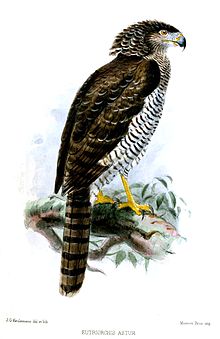| Madagascar serpent eagle | |
|---|---|

| |
| Conservation status | |
 Endangered (IUCN 3.1) | |
| Scientific classification | |
| Domain: | Eukaryota |
| Kingdom: | Animalia |
| Phylum: | Chordata |
| Class: | Aves |
| Order: | Accipitriformes |
| Family: | Accipitridae |
| Subfamily: | Circaetinae |
| Genus: | Eutriorchis Sharpe, 1875 |
| Species: | E. astur |
| Binomial name | |
| Eutriorchis astur Sharpe, 1875 | |
The Madagascar serpent eagle (Eutriorchis astur) is a species of bird of prey in the family Accipitridae. It is placed in the monotypic genus Eutriorchis. It is endemic to Madagascar. Its natural habitat is subtropical or tropical moist lowland forests. It is threatened by habitat loss.
Description
The Madagascar serpent eagle is a medium-sized raptor with a long rounded tail and short rounded wings. It is dark grey on its back and a lighter grey on its belly, breast, and throat. Dark barring covers the bird's body. It has yellow eyes and a sharp, hooked beak with strong talons. It measures 57 to 66 cm (22 to 26 in) long with a wingspan of 90 to 110 cm (35 to 43 in).
Distribution and habitat
This bird inhabits dense, humid, and broadleafed evergreen forests in northeastern and east-central Madagascar. It rarely ventures above 550 meters (1800 ft).
Ecology and behavior
This serpent-eagle is diurnal. It eats lemurs both large and small, snakes, lizards, and frogs, which it hunts from high perches, swooping down from its perch and grasping its prey in its talons when it spots it.
Conservation
This species was believed to be extinct, with the last confirmed sighting being from 1930. However, sightings in 1977 and 1988 led to hope for the species' rediscovery. It was rediscovered in 1993 by the Peregrine Fund.
The Madagascar serpent eagle is listed as an endangered species on the International Union for Conservation of Nature (IUCN) Red List, with an estimated population of 533 adults. This species is threatened by the destruction of its specialized habitat and a presumed low rate of reproduction.
Etymology
The prefix eu- is Greek for "good". Triorchis is a Latinization (Pliny the Elder) of Greek triórkhēs (τριόρχης), which Aristotle and Theophrastus used for a kind of hawk, possibly the common buzzard. The Greek word means "having three testicles". This erroneous bit of anatomy has been connected with the ease of mistaking a bird's adrenal gland for a testicle.
Astur is Latin for a kind of hawk.
References
- ^ BirdLife International (2016). "Eutriorchis astur". IUCN Red List of Threatened Species. 2016: e.T22695336A93503165. doi:10.2305/IUCN.UK.2016-3.RLTS.T22695336A93503165.en. Retrieved 17 November 2021.
- Thomas M. Brooks; John D. Pilgrim; Ana S. L. Rodrigues & Gustavo A. B. Da Fonseca (2005). "Conservation status and geographic distribution of avian evolutionary history". In Andy Purvis; John L. Gittleman & Thomas Brooks (eds.). Phylogeny and Conservation. Conservation Biology. Vol. 8. Cambridge University Press. pp. 267–294. ISBN 978-0-521-82502-3.
- ^ "Madagascar Serpent Eagle". The Official World Wildlife Fund Guide to Extinct Species of Modern Times. Vol. 1. Beacham Publishing. 1997. pp. 13–14.
- Raptors of the World By Ferguson Lees, Christie, David A.(2001)
- Sutton, Luke J.; Benjara, Armand; Roland, Lily-Arison Rene de; Thorstrom, Russell; McClure, Christopher J. W. (January 2023). "Extensive protected area coverage and an updated global population estimate for the Endangered Madagascar Serpent-eagle Eutriorchis astur". Bird Conservation International. 33: e48. doi:10.1017/S0959270922000508. ISSN 0959-2709.
- Pliny the Elder, Historia Naturalis, Book 10, Chapters 9, 95, 96. English translation from the Perseus Digital Library. Both retrieved on Nov. 16, 2007.
- Liddell, Henry George; Scott, Robert (1940), A Greek-English Lexicon, retrieved 2007-11-15
- Fisher, Peter; Higgins (1998), Olaus Magnus: A Description of the Northern Peoples, 1555, translated by Humphrey, Hakluyt Society, p. 1011n, ISBN 0-904180-59-X, retrieved 2007-11-15. See Olaus Magnus and Historia de Gentibus Septentrionalibus
- Lewis, Charlton T.; Short, Charles (1897), A Latin Dictionary, retrieved 2009-01-15
External links
| Subfamily: Circaetinae | |
|---|---|
| Genus | Species |
| Terathopius | |
| Circaetus | |
| Dryotriorchis | |
| Spilornis | |
| Eutriorchis | |
| Pithecophaga | |
| Genera of eagles, condors and their extinct allies | |||||||||||||||||||||||||||||||||||||||||||||||||||||
|---|---|---|---|---|---|---|---|---|---|---|---|---|---|---|---|---|---|---|---|---|---|---|---|---|---|---|---|---|---|---|---|---|---|---|---|---|---|---|---|---|---|---|---|---|---|---|---|---|---|---|---|---|---|
| |||||||||||||||||||||||||||||||||||||||||||||||||||||
| |||||||||||||||||||||||||||||||||||||||||||||||||||||
| |||||||||||||||||||||||||||||||||||||||||||||||||||||
| Taxon identifiers | |
|---|---|
| Eutriorchis astur |
|


